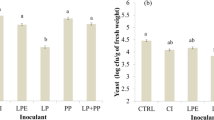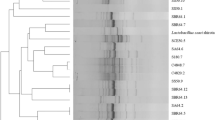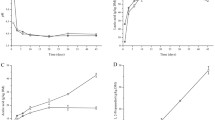Abstract
Two strains ofLactobacillus plantarum were used to inoculate chopped, whole plant corn in a model ensiling system. At specific intervals up to 32 days, pH values and populations of lactic acid bacteria were determined for both uninoculated and inoculated forages in 15-kg minisilos. At all times after the second day, the inoculated forage had lower pH values and higher levels of homofermentative lactobacilli than the uninoculated material. Plasmid profiling indicated that this shift was due to the added strains ofL. plantarum. This study demonstrates that plasmids of naturally occurringLactobacillus plantarum strains are stable during the ensiling process and hence can be used to monitor the succession of introduced organisms at the expense of epiphytic populations.
Similar content being viewed by others
Literature Cited
Anderson DG, McKay LL (1983) Simple and rapid method for isolating large plasmid DNA from lactic streptococci. Appl Environ Microbiol 46:549–552
Chassy BM, Gibson E, Giuffrida A (1976) Evidence for extrachromosomal elements inLactobacillus. J Bacteriol 127:1576–1578
Clewell DB (1981) Plasmids, drug resistance and gene transfer in the genusStreptococcus. Microbiol Rev 45:409–436
Davidson CM, Cronin F (1973) Medium for the selective enumeration of lactic acid bacteria from foods. Appl Microbiol 26:439–440
Davies FL, Underwood HM, Gasson MJ (1981) The value of plasmid profiles for strain identification in lactic streptococci and the relationship betweenStreptococcus lactis 712, ML3, and C2. J Appl Bacteriol 51:325–337
Farrar WE Jr (1984) Molecular analysis of plasmids in epidemiologic investigation. J Infect Dis 148:1–6
Ginn RE, Packard VS, Fox TL (1984) Evaluation of the 3M dry medium culture plate (Petrifilm™ SM) method for determining numbers of bacteria in raw milk. J Food Protect 47:753–755
Holmberg SD, Osterholm MT, Senger KA, Cohen ML (1984) Drug-resistantSalmonella from animals fed antimicrobials. N Engl J Med 311:617–622
Holmberg SD, Wachsmuth KW, Hickman-Brenner FW, Cohen ML (1984) Comparison of plasmid profile analysis, phage typing, and antimicrobial susceptibility testing in characterizingSalmonella typhimurium isolates from outbreaks. J Clin Microbiol 19:100–104
Jacob AE, Shapiro JA, Yamamoto L, Smith ID, Cohen SN, Berg D (1977) Appendix B: bacterial plasmids. In: Bukhari AI, Shapiro JA, Adhya SL (eds) DNA insertion elements, plasmids and episomes. Cold Spring Harbor NY: Cold Spring Harbor Laboratory, pp 606–704
Klaenhammer TR (1984) A general method for plasmid isolation in lactobacilli. Curr Microbiol 10:23–28
Leininger HV (1976) Equipment, media, reagents, routine tests and stains. In: Speck ML (ed) Compendium of methods for the microbiological examination of foods, Washington DC: American Public Health Association, pp. 79–80
Macrina FL, Kopecko SJ, Jones KR, Ayers DJ, McCowen SM (1978) A multiple plasmid-containingEscherichia coli strain: convenient source of size reference plasmid molecules. Plasmid 1:417–420
McDonald P (1981) The biochemistry of silage. New York: John Wiley and Sons
McKay LL (1983) Functional properties of plasmids in lactic streptococci. Antonie Leeuwenhoek J 49:259–274
Meyers JA, Sanchez D, Elwell LP, Falkow S (1976) Simple agarose gel electrophoretic method for the identification and characterization of plasmid deoxynucleic acid. J Bacteriol 127:1529–1537
Mundt JO (1970) Lactic acid bacteria associated with raw plant food material. J Milk Food Technol 33:550–553
Nes IF (1984) Plasmid profiles of ten strains ofLactobacillus plantarum. FEMS Microbiol Lett 21:359–361
Riley LW, Di Ferdinando GT Jr, De Melfi TM, Cohen ML (1983) Evaluation of isolated cases of salmonellosis by plasmid profile analysis: introduction and transmission of a bacterial clone by precooked roast beef. J Infect Dis 148:12–17
Yoshida SI, Ohta H, Taniguchi H, Ogawa M, Mizuguchi Y, Kunifuji Y, Chihara S, Urabe S (1984) Plasmid profiles of penicillinase-producingNeisseria gonorrhoeae isolated in Fukuoka, Japan. Microbiol Immunol 28:955–959
Yu RST, Hung TV, Azad AA (1983) Plasmid complement and sequence homology of some technological strains of lactic streptococci. Aust J Dairy Technol 38:104–109
Author information
Authors and Affiliations
Rights and permissions
About this article
Cite this article
Hill, H.A., Hill, J.E. The value of plasmid profiling in monitoringLactobacillus plantarum in silage fermentations. Current Microbiology 13, 91–94 (1986). https://doi.org/10.1007/BF01568288
Issue Date:
DOI: https://doi.org/10.1007/BF01568288




